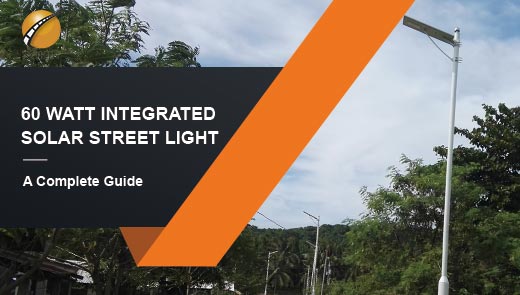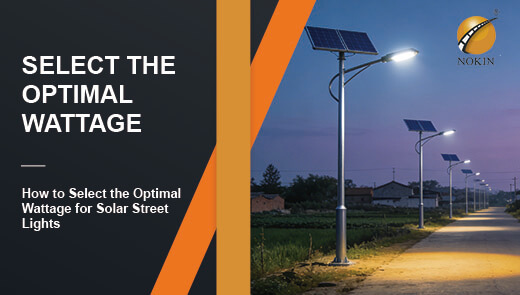Solar-Powered Street Lighting: Benefits And Challenges
Under the background of deep adjustment of global energy structure and comprehensive promotion of sustainable development strategy, solar-powered street lighting, as a typical representative of the integration of new energy technology and lighting field, is reshaping the night ecology of cities and villages with vigorous momentum. It not only carries the expectation of human beings on the efficient use of clean energy, but also is the key key to crack the traditional lighting energy consumption, environmental pollution and other problems.
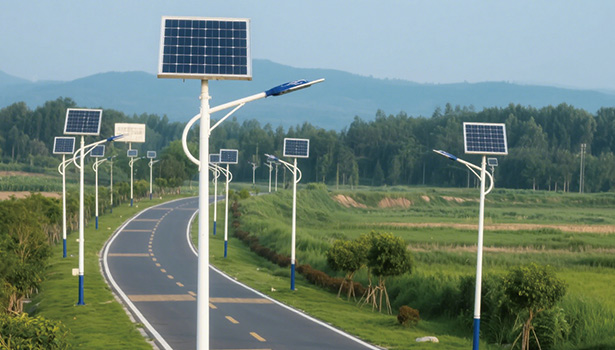
What is solar-powered street lighting?
Solar street light is an outdoor lighting system with solar energy as the core energy source, realizing autonomous lighting at night through photoelectric conversion and energy storage technology. It can be used in a wide range of application scenarios, from streets and parking lots in busy cities to paths in remote villages and mountainous scenic spots.
Solar panel
Solar panel is the “energy source” of solar street light, mostly made of monocrystalline silicon, polycrystalline silicon or thin film materials. Monocrystalline silicon solar panels have a high photoelectric conversion efficiency, up to 25% or more in laboratory environments, and commercially available products can be stabilized at 20% - 23%. Polycrystalline solar panels are relatively low-cost, with conversion efficiencies of around 18% - 20%. Thin-film solar panels, on the other hand, are thin, lightweight and flexible, and although they have a slightly lower conversion efficiency (about 10% - 15%), they have obvious advantages in some special scenarios. These solar panels convert sunlight into DC electricity through the photovoltaic effect.
Charge controller
It is like the “intelligent housekeeper” of the solar street light system. Its role is to regulate the voltage and current output from the solar panel to avoid overcharging or over-discharging the battery. The mainstream charge controllers in the market are divided into PWM (Pulse Width Modulation) and MPPT (Maximum Power Point Tracking).MPPT charge controllers are able to track the maximum power output point of the solar panel more accurately, and can improve the charging efficiency by 10% - 30% under complex lighting conditions compared with PWM controllers.
Battery
As a key component for storing electricity, lead-acid batteries, gel batteries and lithium batteries are commonly used. Lead-acid batteries are inexpensive, but their cycle life is shorter, generally 300 - 500 times; gel batteries are an improved version of lead-acid batteries, the electrolyte is in the form of gel, with better leakage-proof performance, and the cycle life can reach 600 - 800 times; lithium batteries, although costing more, have the advantages of small size, light weight, long cycle life (1,000 - 2,000 times), and low self-discharging rate, which have become the preferred choice for high-end solar street lights. The first choice for high-end solar street lights.
LED lamps
LED lamps have become the standard configuration of solar street lights due to their high luminous efficiency, long life and low energy consumption. Compared with traditional high-pressure sodium lamps, the luminous efficiency of LED lamps can reach 100 - 150lm/W, while that of high-pressure sodium lamps is only 50 - 100lm/W. The life span of LED lamps can reach 50,000 - 100,000 hours, which is much higher than that of high-pressure sodium lamps, which is 10,000 - 20,000 hours.
Light control systems
A common light control system consists of a light sensor and a timer. The light sensor can automatically control the street light to switch on and off according to the ambient light intensity, when the light intensity is lower than 5 - 10lux, the street light will be turned on automatically; when it is higher than 50 - 100lux, it will be turned off automatically. The timer can be set to a fixed switching time according to the season and demand. The more advanced light control system also combines intelligent algorithms that can adjust the working mode in advance according to the weather forecast and historical light data.
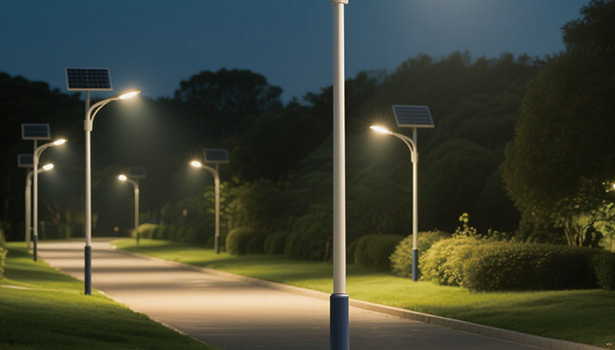
Benefits of solar-powered street lighting
Reduced energy costs
The zero dependence of solar street lights on traditional grid power brings long-term and significant cost savings. Take the main road lighting project of a medium-sized city for example, if 1000 traditional street lights with 100W power are installed, lighting for 12 hours a day, the electricity expenditure for a year is as high as: 1000×0.1kW×12h×365×0.65÷7.2 ≈ 39,541.67 dollars. The use of solar street lights, in the case of normal operation of the equipment, basically do not need to bear the cost of electricity. With the increase of service life, this cost advantage is more and more obvious, 10 years can save nearly 400,000 U.S. dollars of electricity expenses, for the local financial relief of great pressure.
|
Lighting Type |
Annual Electricity Cost per Light (USD) |
10-Year Total Electricity Cost for 1,000 Lights (USD) |
|
Traditional Light |
$50 |
$400,000 |
|
Solar Light |
$0 |
$0 |
Significant environmental benefits
Solar street lights achieve zero pollutant emissions over their entire life cycle. For example, if one million new 60W solar street lights are installed globally each year, carbon dioxide emissions can be reduced by about 262,800 tons per year, which is equivalent to the carbon absorption of planting 15 million adult trees. In addition, its operation process does not produce sulfur dioxide, nitrogen oxides and other harmful gases, avoiding the generation of acid rain, haze and other environmental problems, which is of great significance to improving air quality and protecting the ecological environment. In some ecologically sensitive areas, such as nature reserves, scenic spots, the application of solar street lights can meet the lighting needs, but will not cause damage to the fragile ecological environment.
Low maintenance cost
Traditional street light system has many failure points and cumbersome maintenance work due to the existence of complex cable networks, transformers and other equipment. According to statistics, the average number of maintenance for each traditional street light is about 4-6 times per year, and the cost of each maintenance is about 30-40 dollars, including cable overhaul, bulb replacement, circuit troubleshooting and other work. The structure of solar street light system is relatively simple, and the main maintenance work focuses on solar panel cleaning (1-2 times per quarter, at a lower cost), battery inspection and replacement (once every 3-5 years), and surface cleaning of lamps and lanterns, etc., and the annual maintenance cost per lamp can be reduced to about 7-15 US dollars. Intelligent solar street lamps can also be monitored remotely to grasp the operating status of the equipment in real time and provide early warning of potential failures, which further reduces maintenance costs and time costs.
Safety and reliability
The independent power supply feature of solar street lights plays an important role in the event of power outages caused by extreme weather or grid failures. Community roads installed with solar street lights remain illuminated in the event of widespread power outages across the city, providing a safe environment for rescue teams and residents to pass through. In addition, the solar street light adopts 12V or 24V low-voltage DC power supply system, compared with the 220V high-voltage AC power supply of the traditional street light, which greatly reduces the leakage of electricity, electrocution and other safety hazards, especially for schools, parks, squares and other densely populated places.
Flexible installation
Solar street lights are free from the dependence on grid lines, and their installation is not restricted by geographical location. In remote plateau areas, due to the sparsely populated, costly and difficult to lay the traditional power grid, solar street lights become the first choice to solve the local lighting problems. In some temporary places, such as construction sites, camping bases, solar street lights can also be quickly installed to meet the temporary lighting needs. The installation process does not require large-scale excavation and cable laying, and generally 2-3 people can complete the installation of a street light in half a day, with a short construction period and high efficiency.
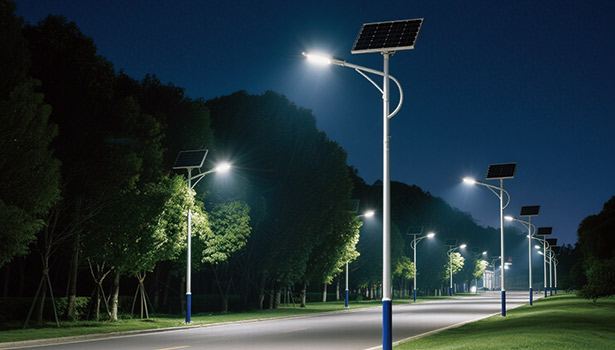
Challenges of solar-powered street lighting
Higher initial investment
The initial cost of solar street light mainly includes solar panels, batteries, controllers, lamps and installation costs. Take a set of medium configuration of solar street lights as an example, the cost of solar panels accounts for about 30% - 40% of the total cost, the cost of batteries accounted for 25% - 35%, plus controllers, lamps and lanterns and installation costs, the initial investment of a single street light between 400 - 1000 dollars. In contrast, the cost of a traditional street light is only $150-$500 per unit. For some economically underdeveloped areas or small communities, there is a large financial pressure to invest a large amount of money in solar street light retrofit at one time. Although in the long run, the comprehensive cost of solar street lights is lower than that of traditional street lights, the high investment in the short run is still the main factor hindering its large-scale promotion.
Constrained by light conditions
There are significant differences in light resources in different regions. In areas with insufficient light, the power generation of solar panels can not meet the demand for nighttime lighting, and in order to ensure the length and brightness of lighting, it is necessary to increase the area of solar panels or configure larger-capacity storage batteries. For example, in a region with poor light resources, a single 100W solar panel and 100Ah battery can meet the lighting demand, but in practice, it may need to be replaced by a 150W solar panel and 150Ah battery, which increases the cost of the equipment by 30% - 50%. In addition, extreme weather conditions such as heavy rain, snow, sand and dust can cause the surface of the solar panels to be obscured or damaged, affecting power generation efficiency.
Battery life and replacement issues
The performance and life of batteries directly affect the use and cost of solar street lights. After 3 - 5 years of use, the capacity of lead-acid batteries and gel batteries will drop to 60% - 80% of the initial capacity, which can not meet the normal lighting requirements and need to be replaced. Take a set of 48V, 100Ah lead-acid batteries as an example, its market price is about 200 - 300 U.S. dollars. Although the life of lithium batteries is relatively long, but after 5 - 8 years of use, there will be capacity degradation problems, and lithium battery replacement costs are higher. At the same time, used batteries contain lead, cadmium and other heavy metals, if not handled properly, will cause serious pollution of soil and water, the need to establish a comprehensive recycling system, which undoubtedly increases the cost of use and environmental management difficulties.
Light pollution
Unreasonable street light design and installation will lead to light pollution. Part of the solar street light for the pursuit of high brightness, the use of high-power lamps and lanterns and not scientific light distribution design, so that the light to the surrounding uncontrolled scattering. This will not only interfere with the normal activities of nocturnal organisms, such as affecting the migration routes of birds and the breeding behavior of insects, but also have a serious impact on astronomical observations. In the vicinity of some astronomical observatories, stray light from too many bright street lamps can bias the observation data of astronomical telescopes and affect scientific research. In addition, light pollution will also affect the night rest of residents, long-term exposure to bright light may lead to reduced sleep quality, impaired vision and other health problems.
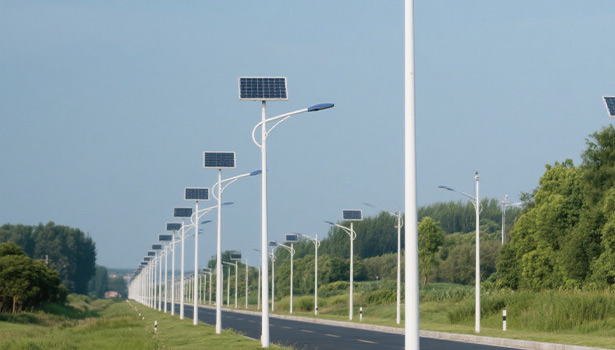
The future of solar-powered street lighting
Intelligent interconnection upgrade
The in-depth application of Internet of Things (IoT) technology will enable solar street lights to realize comprehensive intelligence. By integrating a variety of sensors (e.g. light sensor, temperature sensor, current sensor, etc.) and communication modules (e.g. 4G, 5G, NB-IoT) on the street lights, the management personnel can obtain real-time operation data of each streetlight, including solar panel power generation, battery power, lamps and lanterns working status, etc., by using the cell phone APP or cloud management platform. When equipment failure is detected, the system will automatically issue an alarm and accurately inform the location of the faulty street light through the positioning system. At the same time, the intelligent solar street light can also automatically adjust the brightness according to the data of traffic flow and people flow. For example, when there is very little traffic late at night, the brightness of the streetlight is automatically reduced to 30%, and when a vehicle or pedestrian is detected, the brightness is quickly restored to 100%, which not only ensures safety, but also realizes energy saving.
Introduction of motion sensor technology
The popularization of motion-sensing technology will further enhance the energy-saving effect and safety of solar street lights. When the human infrared sensor or microwave radar sensor detects the movement of an object within a certain range, the streetlight will immediately increase its brightness; when the object leaves, the streetlight will automatically return to a low-brightness state within a set period of time (e.g. 30 seconds - 1 minute). This “on-demand” mode can save 30% - 50% of electricity compared to traditional fixed brightness lighting. In addition, motion sensing technology can be linked with the security system to automatically send alert messages to security personnel when abnormal prolonged stays or frequent movements are detected, enhancing the safety and security capabilities of public areas.
Integration into smart city construction
In the overall planning of the smart city, solar street light will become an important information collection and transmission node. By docking with the traffic management system, solar street lights can monitor real-time traffic flow, speed and other traffic data, and feedback the information to the traffic command center to achieve intelligent traffic scheduling. Combined with the security monitoring system, the camera on the street light can monitor the public area in real time, use artificial intelligence algorithms to identify abnormal behaviors, such as fights and thefts, and report to the police in time.
In addition, solar street lights can be integrated with environmental monitoring sensors to monitor air quality, noise pollution and other environmental data in real time, providing data support for urban environmental governance. At the same time, as the carrier of 5G micro-base station, solar street light will help the full coverage of urban 5G network, realizing “one pole for multiple uses” and enhancing the comprehensive utilization efficiency of urban infrastructure.
Technological innovation breakthrough
In the field of photovoltaic technology, chalcogenide solar cells have become a research hot spot due to their unique material properties and low-cost advantages. Under laboratory conditions, the conversion efficiency of chalcogenide solar cells has exceeded 26%, close to the level of monocrystalline silicon batteries, and its production cost is only 1/3 - 1/2 of monocrystalline silicon batteries. In terms of energy storage technology, new lithium batteries continue to make breakthroughs, solid-state lithium batteries through the use of solid-state electrolyte, improving the energy density and safety of the battery, energy density of up to 350 - 400Wh/kg. Graphene batteries have also shown great potential, with a theoretical full charge in 10 minutes and a cycle life of more than 3,000 cycles. The innovation and application of these technologies will significantly improve the performance of solar street lights, reduce costs and promote their wider application.
With its outstanding advantages in energy saving, environmental protection and safety, solar street light provides an ideal solution for the sustainable development of the lighting industry. Although currently facing challenges such as high initial investment, strong light dependence and limited battery life, these issues will be gradually resolved with continuous technological innovation and progress, as well as policy support and market promotion. In the future, solar street lights will develop in the direction of intelligence, high efficiency and multi-functionality, deeply integrate into the construction of smart cities, and become an important support for building a green, low-carbon and intelligent living environment, illuminating the future road of sustainable development for mankind.

